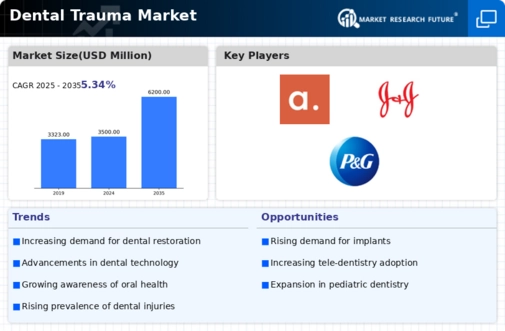Market Analysis
In-depth Analysis of Dental Trauma Market Industry Landscape
The dental trauma market focuses on diagnosing, treating, and managing tooth and supporting structural damage. Dental trauma, which typically results from accidents or sports, demands a full understanding of its prevalence, diagnostic tools, and evolving dental healthcare treatment techniques. First, determine dental trauma frequency and causes to grasp the market. Many are caused by falls, accidents, and sports injuries. The market adapts to severe dental injuries from small fractures to big avulsions. Dental Trauma market form depends on modern diagnostic technologies. Cone-beam computed tomography (CBCT) and X-rays can diagnose soft tissue injuries, fractures, and dislocations. Combining these technologies improves treatment planning efficiency and precision. Many dental trauma therapies affect market dynamics. For fractured teeth, bonding, splinting, or realignment may work immediately. Complex cases may need root canal therapy, tooth extractions, or dental implants. The industry provides various trauma therapies depending on severity. Education and prevention are becoming more important in the industry. Sports mouthguards and other protective gear prevent injuries, while oral harm awareness programs emphasize rapid treatment. These programs impact market trends by promoting proactive oral care. Child dental trauma alters market dynamics. Teething is frequent in youngsters and requires special care. The industry adapts by providing kid-friendly treatments, emphasizing prevention, and addressing the psychological repercussions of dental trauma on younger patients. The need for emergency dental care is crucial to market dynamics. Dental trauma patients should be treated immediately to prevent complications. Access to emergency dental care greatly impacts the market. The trauma rehabilitation industry includes cosmetic dentistry. Restorative procedures include dental bonding, veneers, and crowns improve function and appearance. Stressing tooth restoration influences patient happiness and cosmetic dentistry demand. Geography, healthcare delivery techniques, and dental care culture affect global dental trauma market dynamics. Dental trauma prevalence and treatment depend on socioeconomic factors, including dental care accessibility, worldwide. Teleconsultations and teledentistry are transforming the market. Telecommunications technology allows virtual assessments, consultations, and follow-ups, improving dental care, particularly in emergencies, and oral trauma therapy. Partnerships with emergency doctors and orthopedists affect market dynamics. Dental trauma that involves maxillofacial damage requires comprehensive treatment. Collaboration offers better outcomes and comprehensive patient care. Market dynamics increasingly depend on patient experience and happiness. Patient satisfaction is improved via pain control, less intrusive treatments, and tailored therapy. Happy dental trauma patients advocate the service to friends and family, affecting the market. Research and innovation affect the dental trauma sector. Bioengineering, biomaterials, and regenerative dentistry may improve treatment outcomes, tissue regeneration, and the long-term effects of severe oral trauma. The dental trauma industry has a promising future due to research, technological advances, and patient-centered and preventive therapy. Addressing market dynamics as the dental healthcare environment develops ensures that dental trauma therapy will enhance results for trauma victims.






Leave a Comment